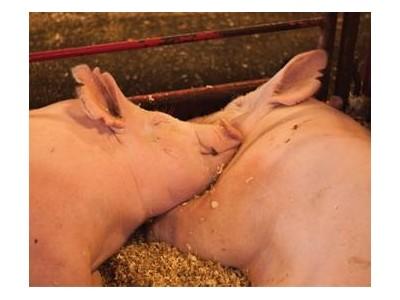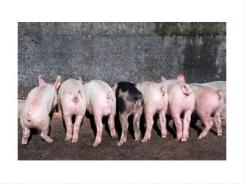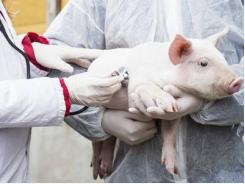Health is the biggest barrier for rearing gilts in the US

While genetics and nutrition are the drivers in herd advancement, health is the variance from herd to herd.
The U.S. swine industry is entering a new frontier that has the potential to lower herd-health risks from incoming gilts.
The U.S. swine industry is embracing technology that will shape how gilts are reared. Using tools that read genomic sequencing, veterinarians and producers will soon have the ability to see what type of pathogens are present in gilts and the sow herd. Knowing the type of pathogens present and how they interact with pigs’ bodies is key to acclimating gilts to the sow herd.
“Eventually we’ll be able to know when a gilt is ready to enter the sow herd and what her ratio of immunity to pathogens is and if it can be acclimated to the sow herd without throwing the herd health off balance,” said University of Illinois veterinarian James Lowe.
Currently, the best way to balance health between the sow herd and incoming gilts is through timed acclimation. However, knowing the precise pathogens and ratio of pathogens to immunity would give those in the industry a better idea of when gilts are ready to join a herd. “Ideally when we bring a gilt onto the farm, we want her to go into the sow herd when she arrives,” said Lowe. “But if we add enough naive animals to the herd, it will disrupt the health of the herd.” Likewise, gilts that bring in more disease than the sow herd can accommodate also risk disrupting the health of the entire herd. And with good health being the main variance from herd to herd, it is vital for the U.S. swine industry to gain the same precision found in the broader fields of genetics and nutrition.
Past solutions
In the late 1990s, the U.S. swine industry went through massive innovation, building operations that were ideal for genetic improvement and nutrition advancement. Hog producers went from thinking that 2,500 was the maximum number of sows they could handle on their farms to having a minimum of 2,500 sows on their farms. This made it more cost-effective for producers to make genetic and nutrition advancements with their herds. But it also made introducing gilts into the herd a larger health risk. To overcome this risk, the U.S. swine industry uses two different models for raising gilts and acclimating them to the sow herd: off-site and on-site rearing.
Off-site rearing
Larger operations tend to raise gilts in off-site facilities using multiplier groups; this is more cost-effective for such operations. More attention is put on genetic potential and nutrition. Mature gilts are brought onto the farm between 150 and 200 days old. These gilts are then acclimated to the sow herd for approximately three to nine weeks before they enter the herd.
- Pros: Gilts that are raised offsite on a multiplier farm are more likely to be genetically advanced, and have a more appropriate diet. This system also works well for eliminating costs with non-select gilts. Gilts are preselected so that the producer doesn’t risk losing money on non-select gilts.
- Cons: Unfortunately, it is difficult to thoroughly acclimate gilts to the sow herd, as well as acclimate the sow herd to the incoming replacement gilts. Acclimation and isolation take time—at least 30 days for acclimation and 30 days for isolation.
On-site rearing
On-site rearing is more common in smaller operations and operations that may be at a higher risk of bringing disease onto their farm. Young gilts are brought onto the farm at 21 days post-weaning and kept in a barn adjacent to the breeding herd. Ideally these gilts go through the same selection process as gilts that are reared on off-site farms and are properly preconditioned for conceiving, gestating and lactating.
- Pros: Exposing the gilts to the sow herd at an early age minimizes the risk of disrupting the herd health. Because gilts are on the farm at an early age there is less chance that they will be rushed through acclimation period. Thus lowering the overall health risk.
- Cons: Unfortunately there is a management cost increase due to genetic selection and preconditioning. Gilts raised on-site may not advance the herd as quickly due to the extra management needed for genetic selection and preconditioning.
Exploring new solutions
The U.S. swine industry is currently working on fine-tuning tools such as the polymerase chain reaction (PCR) testing for depicting the type of pathogens present and their interaction with the pig. Ideally, this will become more widely available, more affordable, and simple to use.
Lowe said that with new technology, the swine industry will be able to understand and describe the number and ratio of bugs that are present in a gilt, as well as the type of bug, and how those bugs talk to the pigs’ immune systems. “There are lots of smart people working on this,” he said. “As a veterinarian, it is really exciting to see this new frontier within my practice lifetime.”
Concerns
“There is a lot of complicated, hard work to do,” Lowe said. “But there is a lot of technology available to look at these critters easily.” A lot of these pathogens are opportunist pathogens that are present all the time, he explains. The goal is to be able to know if the ratio of pathogens and immunity is in balance.
Currently it is expensive to use molecular technology commercially, although the price of equipment is steadily becoming more affordable and easier to use. There is a whole generation of PCR tests that originally were used solely as research tools; today they are commercially available and simpler to use. This allows veterinarians to use advanced sequencing to see every bacteria that is present in the pig. Unfortunately it takes weeks to months to do the testing and data processing. And one test can cost about $3,000. The testing also requires highly trained technicians to process the data.
The road ahead
By meshing engineering with biology, the swine industry will have fast, reliable and affordable tools to help understand and describe the number and type of bugs on a pig and how the bugs interact with the immune system. This will give the swine industry the same type of precision that general geneticists and nutritionists have. There is a lot of work left to do, but the industry is confident that this is a breakthrough that will be available and adopted during this generation.
Related news
Tools

Phối trộn thức ăn chăn nuôi

Pha dung dịch thủy canh

Định mức cho tôm ăn

Phối trộn phân bón NPK

Xác định tỷ lệ tôm sống

Chuyển đổi đơn vị phân bón

Xác định công suất sục khí

Chuyển đổi đơn vị tôm

Tính diện tích nhà kính

Tính thể tích ao




 US pig industry puzzled by Senecavirus A spike
US pig industry puzzled by Senecavirus A spike  EU pig producers on high alert for African…
EU pig producers on high alert for African…